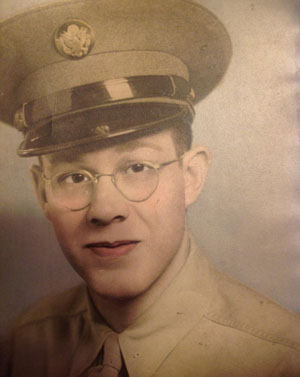
Courtesy Pete Kavadas (nephew)

Remember...
Pete Kavadas
1921-1944
"Success is not final, failure is not fatal: it is the courage to continue that counts."
Winston S. Churchill
 Courtesy Pete Kavadas (nephew) |
Remember...Pete Kavadas
|
U.S. Army Private First Class Pete Kavadas was born on September 25, 1921, in Follansbee, West Virginia, to George Kavadas and Mary Kohelis Kavadas. Pete's parents emigrated from Greece in the early 20th century. He had a younger brother named Mike Kavadas. Before the war, Pete worked at the coke plant in Wheeling, West Virginia, that was run by the Wheeling Steel Corporation. He also worked at some time for the Timken Roller Bearing Company in Canton, Ohio. Prior to entering the workforce, he attended high school at Follansbee High School, where he received his high school diploma before leaving for war. He was a member of The Holy Trinity Greek Orthodox Church in Steubenville, Ohio, which most likely was the Greek church closest to his home.
Pete Kavadas registered for the draft on October 13, 1942, in Clarksburg, West Virginia. Kavadas originally did not think that his draft number would be called. To his surprise, he was later called up in the draft that had been instated by President Roosevelt. Before he was sent to war, Pete told his brother Mike that he did not expect to come back from the war. Pete's last request for his brother was that if he (Mike) had a son that his son be named after him since Pete was not married and did not have any children of his own. Pete's brother Mike wanted to honor his brother if that was the case, so when Pete was killed in World War II, Mike named his son after his brother Pete Kavadas.
Pete was assigned to the Army's 331st Infantry Regiment, 83rd Infantry Division, F Company, for the war. Pete Kavadas' regiment saw their first fighting in June 1943 when they were part of the invasion of France from Britain. The regiment was just over a year old at the time of his death on July 4, 1944. It was decimated during the week of July 4th with hundreds of deaths and casualties.
Pete Kavadas was killed on July 4, 1944, as a result of heavy machine gun fire from the German forces. His company, F Company, had the most casualties of any company that day. Kavadas' regiment lost roughly 1,300 men that day and only advanced 200 yards down the road toward the German forces. The Germans held the high ground, while the Americans were left fighting from a rather exposed and poor battle position. Kavadas died from extensive battle wounds. While one of the regiment's medics was attending to his wounds, he called for his mother in Greek shortly before he died.
Family information and some photos provided by Pete Kavadas' nephew and namesake, Pete Kavadas.
Article prepared by Taylor Giles, George Washington High School, Advanced Placement U.S. History
May 2015

West Virginia Archives and History welcomes any additional information that can be provided about these veterans, including photographs, family names, letters and other relevant personal history.